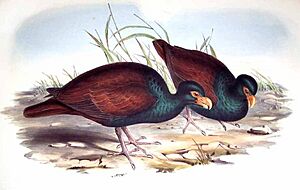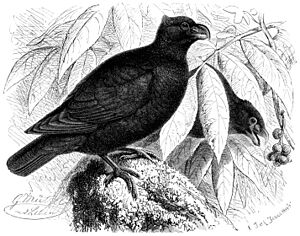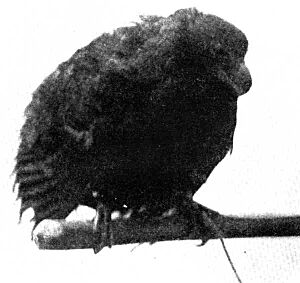Tooth-billed pigeon facts for kids
Quick facts for kids Tooth-billed pigeon |
|
|---|---|
 |
|
| Mounted specimen at the Naturalis Biodiversity Center | |
| Conservation status | |
| Scientific classification | |
| Genus: |
Didunculus
|
| Species: |
strigirostris
|
The tooth-billed pigeon (Didunculus strigirostris), also known as the manumea, is a large pigeon that lives only in the country of Samoa. It is the only living species in its genus, Didunculus. There was once a similar pigeon, the Tongan tooth-billed pigeon, but it is now extinct. We only know about it from old bone pieces found in Tonga.
This special bird is the national bird of Samoa. You can even see it on the 20 tālā banknotes and the 50 sene coins. The tooth-billed pigeon lives only in Samoa's main rainforests. Sadly, it is an endangered species, with only a few hundred birds left in the world.
Contents
What Does the Tooth-Billed Pigeon Look Like?

The tooth-billed pigeon is a medium-sized pigeon, about 31 cm (12 inches) long. It has dark feathers, reddish feet, and red skin around its eyes. Its head and neck are greyish with a slight blue-green shine. The tail and wing feathers are a reddish-brown color. Other wing feathers are blackish.
This bird has a large, curved, and hooked bright red bill. The lower part of its bill has special tooth-like bumps. Both male and female pigeons look similar. Young pigeons, called juveniles, are duller in color. Their heads are browner, and their bills are black with only a pale orange base.
The tooth-billed pigeon drinks water in a very unusual way for a pigeon. Most pigeons suck up water like using a straw. But this bird scoops water up with its bill, just like many other types of birds do.
How Scientists Study the Tooth-Billed Pigeon
Scientists first found this bird around 1839. Its discovery was announced in 1844 by Hugh Edwin Strickland. William Jardine officially described the bird in 1845. He named it Gnathodon strigirostris, but that name was already used for a type of mollusc.
The tooth-billed pigeon does not have any close living relatives. However, genetic studies show it is related to the dodo, an extinct bird. In fact, the name Didunculus means "little dodo." Some people even suggested calling it the "dodlet." Its jaw and tongue, and its bill that looks a bit like a parrot's, made some think it was related to parrots. But these features are just because of what it eats, not because it's truly related to parrots.
Where Does the Tooth-Billed Pigeon Live?
The tooth-billed pigeon lives only in the untouched forests of Samoa in the Pacific. Important places where it lives include the Central Savai'i Rainforest, Tafua Preserve, and the Fagaloa Bay – Uafato Tiavea Conservation Zone on Upolu Island. It also lives on Nu'ulua island.
Scientists do not know much about how these birds live or what they do every day. But they believe the pigeons eat the fruits of a tree called Dysoxylum. This tree is part of the mahogany family. Old writings from the 1800s suggest that baby pigeons stay on the forest floor. However, we still do not know if their nests are in trees or on the ground.
Why the Tooth-Billed Pigeon Needs Our Help
The tooth-billed pigeon is in great danger. It is listed as critically endangered on the IUCN Red List of Threatened Species. This means it faces a very high risk of becoming extinct in the wild.
There are several reasons why this bird is in trouble:
- Loss of Home: Its forest home is shrinking.
- Small Area: It lives in a very small part of the world.
- Few Birds Left: There are only a few hundred individuals remaining.
- Hunting: People sometimes hunt these birds.
- Storms: Strong storms like cyclones can harm their habitat.
- Introduced Animals: Animals brought to Samoa, like pigs, dogs, rats, and cats, can also hurt the pigeons.
Surveys show that only about 70 to 380 tooth-billed pigeons might be left in the wild. Sadly, there are no tooth-billed pigeons living in zoos or special centers to help them breed. Until 2013, no young pigeons had been seen in recent surveys. Then, one young bird was spotted in Savaii. It is likely that many young birds do not survive. The birds we see might mostly be older adults.
To save this species, people need to learn why hunting them is harmful. We also need to understand more about how they live and why their numbers are dropping. Controlling animals like rats and cats is very important. Stopping the cutting down of old-growth forests is also key to protecting these amazing birds. In 2020, people heard and saw the bird again during a survey of forests on Savai'i. This gives hope for its future.




